This question should be answered with a written narrative no
This question should be answered with a written narrative, not bullet points or a telegraphic style. This should be an essay. Discuss the various types of genome maps, the strengths and weaknesses of each type, and the benefits of integrating these different types of maps.
Solution
Genetic-linkage mapping. Genetic-linkage maps illustrate the order of genes on a chromosome and the relative distances between those genes. Originally, these maps were made by tracing the inheritance of multiple traits, such as hair color and eye color, through several generations.
Genetic-linkage mapping is possible because of a normal biological process called crossing over, which occurs during meiosis—a type of cell division for making sperm and egg cells. During one stage of meiosis, chromosomes line up in pairs along the center of a cell, where they sometimes \"stick\" to each other and exchange equivalent pieces of themselves. This sticking and exchanging is called crossing over, and is a relatively common event: on average, a chromosome pair undergoes crossing over about 1.5 times during the formation of each sex cell in humans.
For example, imagine a man who has one chromosome with brown-eye and brown-hair genes, and another chromosome with blue-eye and blonde-hair genes in his cells. Usually, his sperm cells will have either brown-eye and brown-hair genes, or blue-eye and blonde-hair genes. But if crossing over occurs, the man will produce one sperm cell with brown-eye and blonde-hair genes, and another with blue-eye and brown-hair genes.
In short, crossing over produces chromosomes with new combinations of genes—and offspring, called recombinants, with new combinations of traits not seen in either parent. Generally the closer two genes are on a chromosome, the less likely they are to be separated by crossing over.
This means that traits that are inherited together most often are probably influenced by genes that are close to each other on a chromosome. On the other hand, traits that are inherited together less often are probably influenced by genes that are farther apart. Thus, by following several traits through generations and recording how often recombinants occur, one can map the relative position of corresponding genes.
A. H. Sturtevant, then a student at Columbia University, made the first genetic-linkage map of fruit fly genes in 1913—decades before scientists even knew that genes are made of DNA. He found, for example, that leg length was inherited with eye color more often than with wing length, and that wing length was inherited with eye color more often than with leg length. Thus, he concluded, the gene for eye color must be between the genes for wing length and leg length in the fruit fly genome.
But because the frequency of crossing over varies at different places in the genome, these early genetic-linkage maps only gave the relative positions of genes, not their physical locations in the genome or their actual distances, in DNA base pairs, from each other. In addition, the maps were based on the inheritance of traits, not genes, and this limited the possible landmarks to characteristics that were visible or measurable in some way.
Today, scientists make genetic-linkage maps by tracing the inheritance of certain DNA sequences the same way they once traced the inheritance of visible traits. The genome contains many places where the DNA sequence varies from person to person (where I have AAC you have AAG, for example). These sequence variations, or polymorphisms, make up many of the landmarks on modern genetic-linkage maps and enable scientists to anchor genes to their true physical locations in the genome.
Physical mapping. Physical maps, by contrast, always give the physical, DNA-base-pair distances from one landmark to another.
In the late 1970s, scientists developed new and efficient ways of cutting the genome up into smaller pieces in order to study it. Around the same time they made the first physical maps by using the overlapping DNA sequences at the ends of the genome pieces to help them keep track of where the pieces came from. (The process had a lot in common with the assembly step of genome sequencing.) In other words, a physical map was simply an ordered set of DNA pieces.
This worked okay for a while, but then more and more scientists started getting interested in the genome, and they were all cutting it up in different ways and building physical maps from different sets of DNA pieces. The scientists couldn\'t share information with each other, because they each had maps written, in effect, in a different language. Moreover, the landmarks they were using weren\'t necessarily unique—that is, a landmark could appear in more than one place in the genome, so finding a landmark didn\'t necessarily tell you where you were.
Today, genome scientists use landmarks known as STSs to help them find their way around the genome. Each STS, or \"sequence-tagged site,\" is a unique DNA sequence—one that is found in only one place in the genome—and is a few hundred base pairs long. Some STSs are parts of genes, but an STS can come from anywhere in the genome as long as it is unique.
No matter how you cut up a genome, STSs will tell you where the pieces belong. For example, once an STS has been added to the genome map, you can figure out whether any piece of DNA contains that STS landmark. If it does, you know exactly where in the genome that piece of DNA belongs.
Scientists began to use STSs to construct maps in the late 1980s. Thus, physical maps have evolved from an ordered set of DNA pieces (which can be used only by people who have the same set of pieces) into a set of landmarks based on unique DNA sequences (which can be used by any scientist the world over).
Advantage and Disadvantages of Linkage Studies
Linkage studies are good for localising areas of disease risk across the genome. They can also be used to study multiple genetic markers simultaneously. There are however several disadvantages to linkage studies. Researchers need to identify a large number of families with several affected generations. If the disease is of late-onset with a high mortality, finding families with more than one affected generation will be difficult. Linkage studies are less helpful for complex traits, such as diabetes where multiple genes are important in disease causation.
Gasser and colleages* studied several families who had multiple members affected with Parkinson’s disease. The purpose of this study was to find a genetic marker that increased susceptibility to the condition. Two families that were thought to show the greatest potential for linkage underwent genome wide scans and were found to have several markers on chromosome 2p that were inherited with the condition. This area was more closely investigated by the researchers, using the remaining families, and the researchers found the most likely location of the locus was 2p13.
Other groups of genome maps are as follows
Formal genetic maps are databases, represented as text or graphic figures, that can be collected/organized/formulated and constructed for nearly any, and every, structural or functional region of the genetic material. Though these maps are basically descriptive, their analysis can provide relevant crucial data that can be applied for different purposes in many fields. The more comprehensive these maps are the more significant information that can be provided through their analysis. Genetic maps comprise four main categories: physical maps detailing the structural characteristics of different regions/sequences of both the nuclear and the mitochondrial genomes, functional maps describing the varied functional potentials of the different components of the genome/transcriptome/proteome, experimental induced maps that are intentionally designed and constructed for specific purposes and constructed maps that are deduced and extracted from other formal maps to serve particular targets that cannot be achieved solely by the constituent maps.
Formal genetic maps comprise two main groups: physical genetic maps and constructed genetic maps. Physical genetic maps reflect data that represent naturally occurring physical situations of the genetic material, like chromosomal locations of genes or chromosomal maps. Constructed genetic maps, on the other hand, comprise data observed, collected and analyzed from research studies, e.g., linkage maps, as well as data generated through experimentally induced situations, e.g., radiation hybrid maps. However, it must be emphasized that apart from some physical genetic maps, the differentiation between the two groups of genetic maps is not absolute, considerable overlap between physical and constructed maps do exist and some types of genetic maps can be considered within the context of both groups. For instance, linkage maps are constructed based on data analyzed from inbreeding experiments or offspring genotypes, but they also reflect physical situations of genes showing linkage during recombination. Also, oncogene maps, for instance, can be considered within the context of physical genetic maps since they represent specific structural components of the genome as well as within the context of constructed genetic maps because they represent data collected and constructed for particular purposes, e.g., diagnostic approaches to cancer and predictive/prophylactic approaches to individuals prone to have malignant tumors. Many different types of genetic maps can be arbitrarily designed and constructed for specific targets. Functional genetic maps, for example, can be formulated to delineate specific regulatory/intermediary/executive functions of specific structural components of the genome/transcriptome/proteome for particular aims. Proteome maps, for instance, can be constructed based on proteome components of distinctive genetic disorders for diagnostic/prognostic/predictive purposes. They can also be constructed by delineating proteome profiles of particular genomes for comparative characterization of different proteomes of studied organisms. Structural/functional genomic maps are comprehensive databases regarding critical structural components of the genome that mediate vital constitutive and regulatory functions responsible for maintaining many crucial aspects of the genome including genome identity, integrity and stability. These maps include pyknon maps, pseudogene maps, transposon maps and telomere maps.
Categories of genetic maps.
Physical maps
Functional maps
Constructed maps
Induced/experimental maps
1.Genome maps
2. Gene maps
3.Transposon maps
4.Pyknon maps
5.Pseudogene maps
6.Telomere maps
7.Chromosome maps
1.Transcriptome maps
2. Regulatory RNA maps
3.piwiRNA maps
4.Proteome maps
5.Oncoprotein maps
1.Linkage maps
2.Genotype maps
3.Haplotype maps
4.Phenotype maps
5.Disease association maps
1.Inter-species hybridization maps
2. Restriction fragment length polymorphism maps
3.Radiation hybrid maps
4.Probe-specific maps
Genome maps: They are used to determine the location of genes. Maps of genomes are constructed at different levels of resolution using different kinds of information. Depending on the type of map we use, an gene can be located on a particular chromosome, in a specific region of the chromosome, or at its precise location in the chromosome’s DNA sequence. The main types of genome maps are genetic maps and physical maps. Genetic maps Genetic maps are linkage maps. They are linkage maps. Theyn show the relative location of genes on a b chromosome as determined by recombination frequencies. Distances on genetic maps are measuredn in centimorgans (cM). One cM equals 0.01% recombination frequency.
Physical maps: Physical maps show distances between show distances between DNA landmarks. The resolution of landmarks range from recognition sites for restriction enzymes to the ultimate level of detail: the actual DNA sequence. Distances between landmarks on an physical map are measured in base physical map are measured in base-pairs (1000 base (1000 base-pairs equals 1 kilobase kb). pairs equals 1 kilobase kb). The first physical maps were created by cutting genomic DNA with different restriction enzymes. The fragments were then analyzed to determine their size and how they fit together into a continuous segment of the genome called a segment of the genome called a contig. Such a map shows the physical distancen between the different recognition sites of the restriction enzymes.
Functional genetic maps: The significant and beneficial applications of structural genetic maps in different fields of genetics including medical genetics call for construction of parallel functional genetic maps that characterize critical functional regions and transcriptionally active domains of the human genome. Hypothetical applications of functional genomic maps can encompass a wide range of prophylactic, diagnostic and therapeutic applications. For instance, anticipation of possible complications in patients suffering from specific genetic disorders, and of possible health hazards in individuals with susceptible genetic backgrounds based on formal genetic maps or databases of their genomic and proteomic constitution, represents an important prophylactic approach with favorable prognostic prospective in the management of patients with specific genetic diseases and in offering proper counseling advice to their concerned family members.
Functional genetic maps can be constructed for any functional region of the genome. As stated previously, the differentiation between physical or structural genetic maps and functional genetic maps is not absolute Considerable overlap between both types of maps do exist and some types of genetic maps can be considered within the context of both groups. Examples of vital functional genetic maps include exome maps, transposon maps, pseudogene maps, pyknon maps, telomere maps, transcriptome maps and proteome maps.
Applications of formal genetic maps
The bioinformatic databases are represented as, and included within, different types of formal genetic maps that have a wide range of applications in many fields of basic, clinical, diagnostic, therapeutic, prophylactic and applied genetics. Construction of the family pedigree of patients with genetic diseases, or of families seeking counseling advice, constitutes the first step in approaching patients and families having genetic disorders, and represents the simplest and most direct of these applications. Genealogical analysis of data represented by informative symbols of the pedigree allows for deriving relevant genetic information, like the possible pattern of inheritance, and to calculate recurrence risk figures in future offspring.
Progress in analysis of the structural organization of the human genome generates a flood of information leading to characterization of new formal maps of specific DNA markers and regions of both structural and functional significance. These maps represent bioinformatic databases that can have a crucial impact on many aspects of basic as well as of clinical medical genetics. For instance, exome maps comprising detailed information of exons of genes can be constructed and used for both intra and inter-species comparative purposes. Similarly, within the context of pathogenetics, comparison of exome maps of patients with specific idiopathic genetic disorders with those of normal subjects might represent a promising approach that can have many predictive and diagnostic applications in clinical genetics. Other types of molecular maps that can be constructed based on available as well as on the rapidly accumulating databases of human genome structure, e.g., introme maps,pyknon maps, transposon maps, telomere maps and maps of pseudogenes, can also have a wide spectrum of applications in many fields of medical genetics.
The significant beneficial effects and applications of structural genetic maps in different fields of medical genetics call for construction of parallel databases of functional genetic maps that characterize critical functional markers and transcriptionally active regions and sequences of the human genome. Examples of such functional maps can, for instance, include proteome maps comprising both structural protein and enzyme, or catalytic, protein databases. Comparative analysis of these functional protein maps in normal subjects and in patients affected with specific genetically-determined disorders and idiopathic diseases caused by, still, unidentified etiological mechanisms, might prove helpful in revealing the underlying pathoproteomic abnormalities responsible for the development of the specific pathophysiological alterations that characterize the clinical phenotype of each of these diseases. In addition, in a way similar to that of reverse engineering, comparative analysis of normal proteome maps and abnormal proteome maps of specific genetic disorders can disclose underlying pathogenetic mechanisms, pathotranscriptomic differences and causative genetic mutations possibly involved in mediating the pathogenesis and development of these disorders.
Hypothetical applications of functional human genomic maps in medical genetics can include a wide range of countless diagnostic techniques and therapeutic approaches. Comparative analysis of proteome maps of normal cells and those of malignant cells can, for instance, depict functional deviations of the genome in cancer cells and detect oncogenic proteins synthesized and expressed by the malignant cell and responsible for pathogenesis and evolution of the malignant phenotype. Oncoprotein maps constructed from this information would, certainly, have beneficial impact on research studies aiming at better, and proper, understanding of malignant transformation through targeting pivotal oncoproteins that initiate and promote the malignant phenotype of cancer cells. They would, also, have similar significant impact on research studies aiming at designing and tailoring specific therapeutic trials for challenging carcinogenesis through e.g., engineering of monoclonal antibodies against relevant oncoproteins inside intracellular compartments, as well as on cell membranes and within the intercellular environment. Interruption of signaling pathways involved in the mediation of many selective advantageous functions of malignant cells, e.g., enhanced glycolysis, metastasis and neovascularization, which depend on the synthesis of specific oncoproteins could, probably, represent a promising approach in treatment of cancer via disassembly of metabolic and regulatory networks actively participating in malignant transformation and evolution of the malignant phenotype.
On the molecular level, comparative analysis of transcriptome maps of messenger RNA and of different micro RNA species in normal and in diseased subjects could offer remarkable help in the diagnosis of genetic diseases characterized by substantial genomic activities. Malignant cells express large numbers of actively transcribed genes and detailed cancer-specific transcriptome maps could be constructed for pathologically distinct types of malignancies, thus allowing for better understanding of the aberrant phenomena of differential suppression of certain genes and of mass overexpression of specific gene families, e.g., proto-oncogenes, in malignant cells. They can also offer more information on the genic and inter-genic pathogenetic and pathological mechanisms underlying the development of specific types of cancer. Cancer-specific transcriptome maps and oncoprotein maps constructed for pathologically distinct types of malignancies might offer rapid and accurate diagnostic tools of these malignancies when compared with corresponding maps of normal cells. Delineation of the whole spectrum of proto-oncogenes and of oncogenes in the human genome and construction of informative maps detailing relevant databases of this spectrum remains, and represents, a prospective ultimate goal crucial for understanding and designing radical therapies for cancer.
| Physical maps | Functional maps | Constructed maps | Induced/experimental maps |
|---|---|---|---|
| 1.Genome maps 2. Gene maps 3.Transposon maps 4.Pyknon maps 5.Pseudogene maps 6.Telomere maps 7.Chromosome maps | 1.Transcriptome maps 2. Regulatory RNA maps 3.piwiRNA maps 4.Proteome maps 5.Oncoprotein maps | 1.Linkage maps 2.Genotype maps 3.Haplotype maps 4.Phenotype maps 5.Disease association maps | 1.Inter-species hybridization maps 2. Restriction fragment length polymorphism maps 3.Radiation hybrid maps 4.Probe-specific maps |
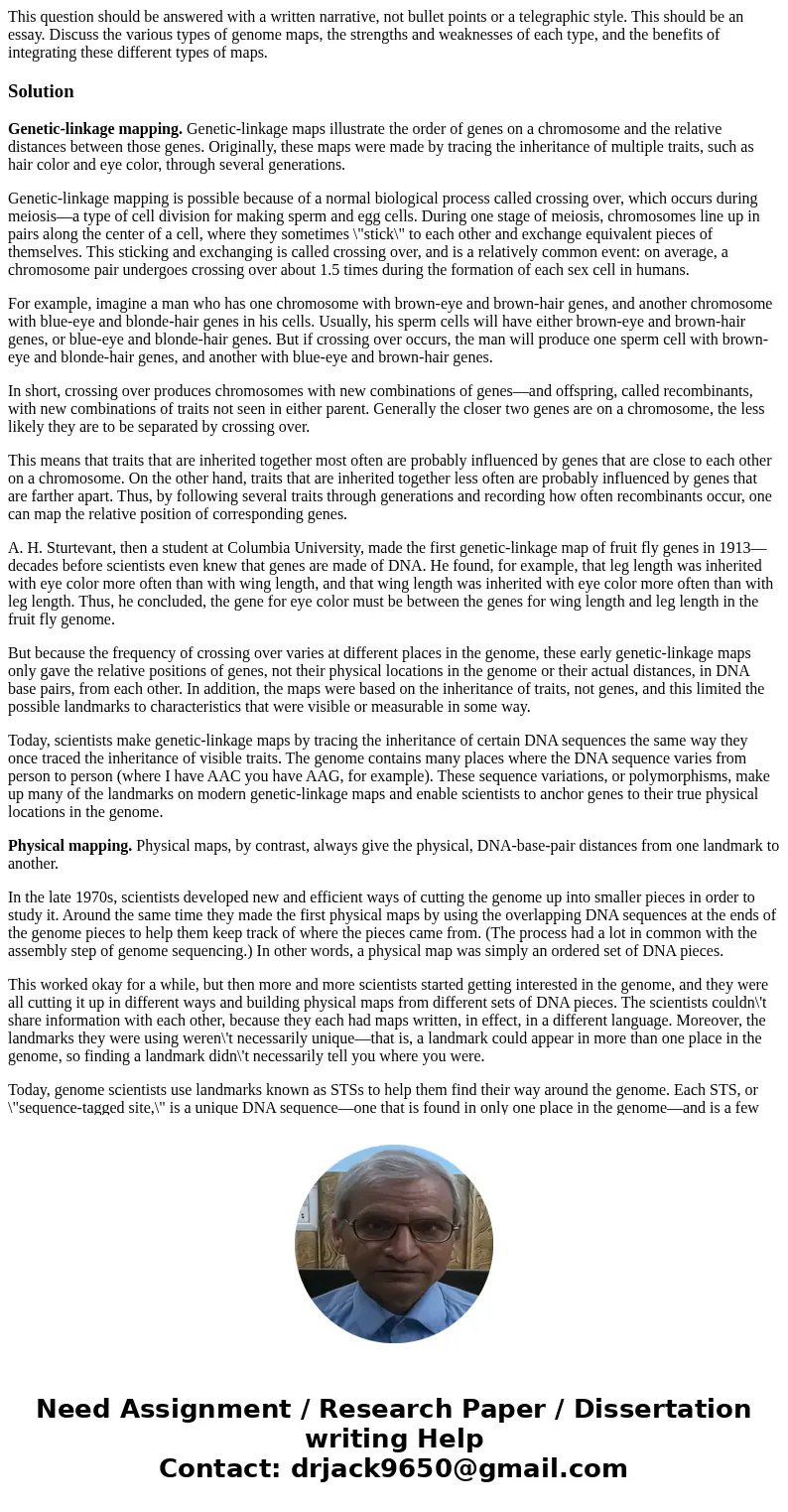
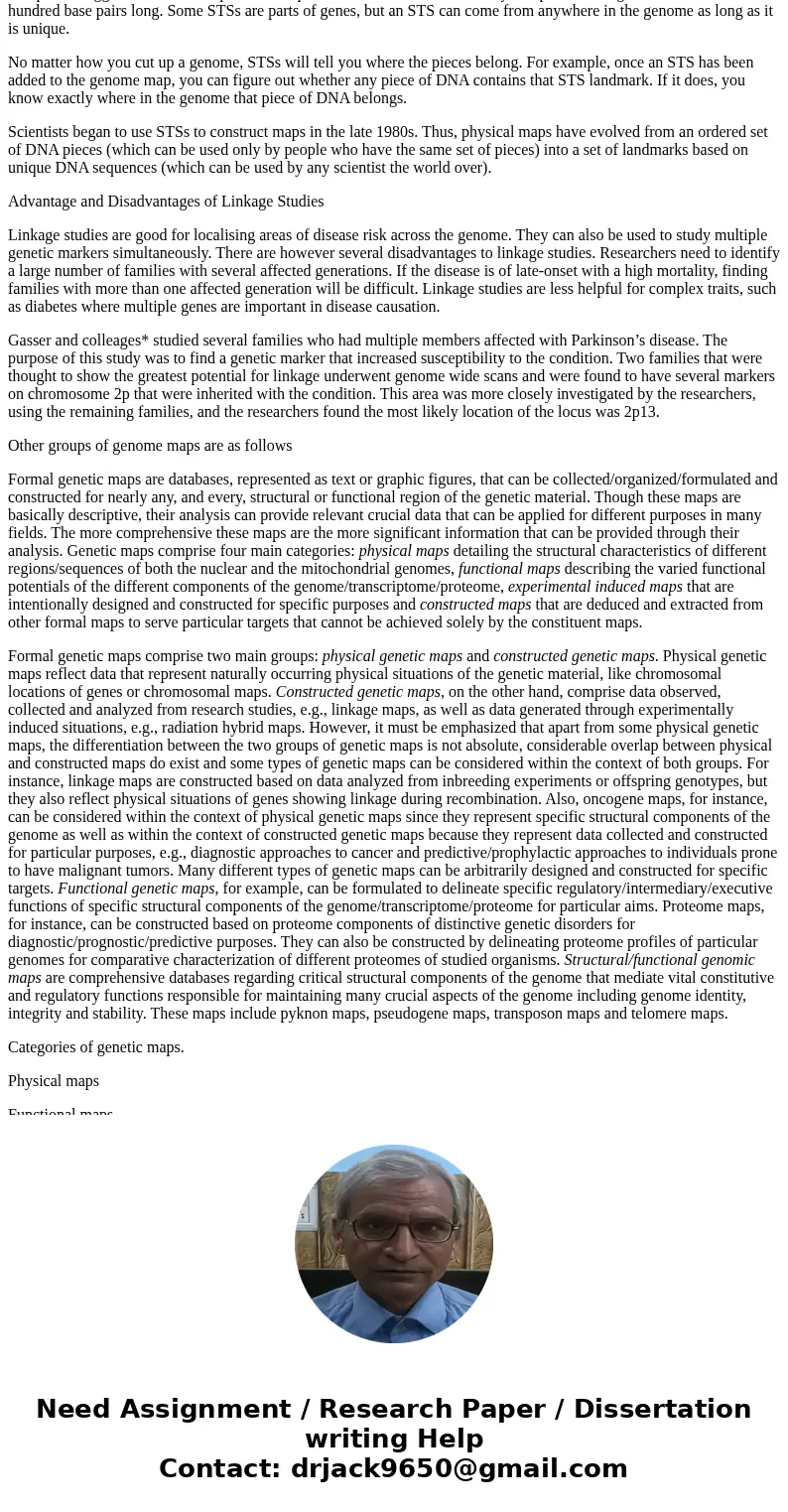
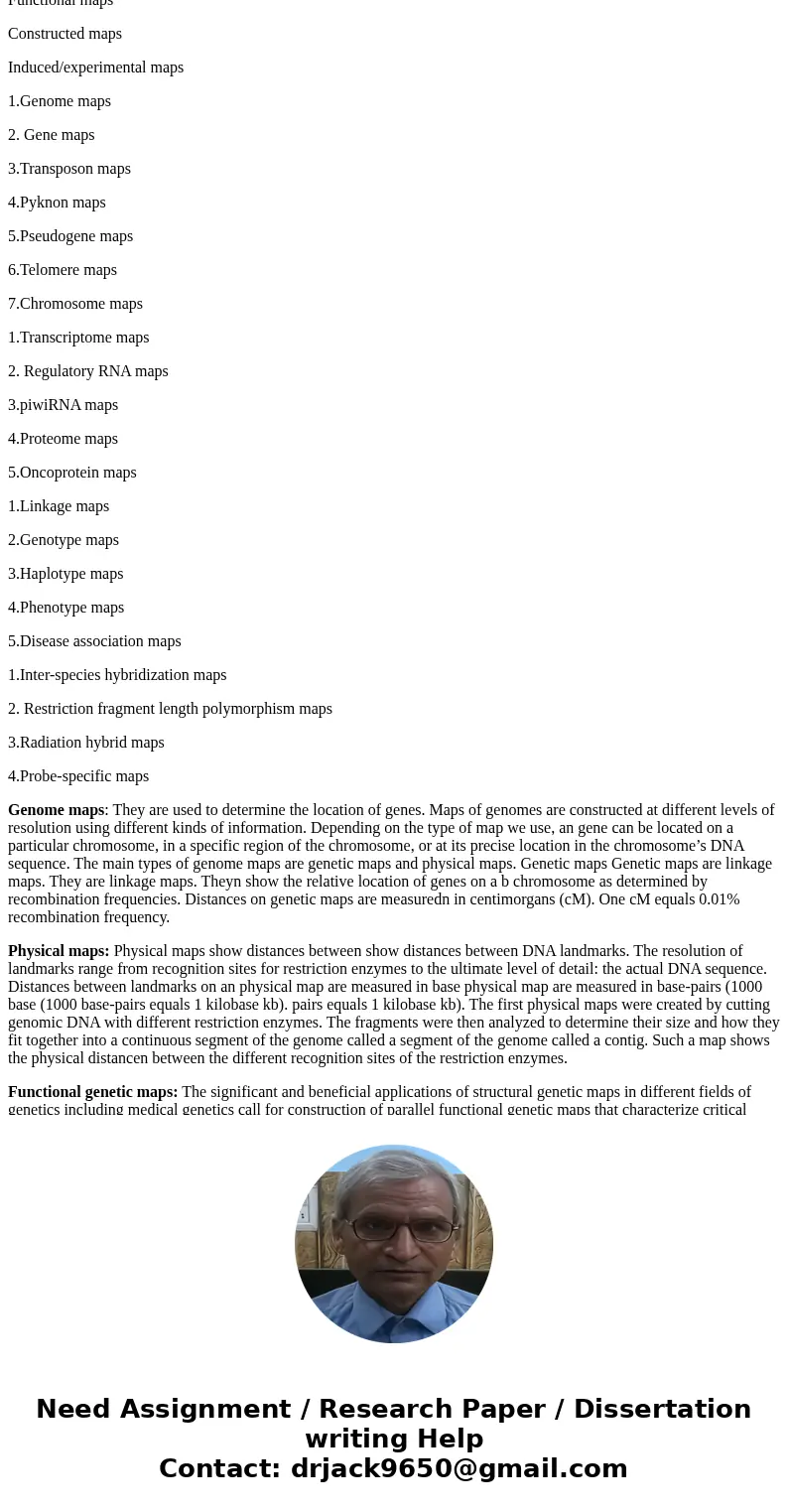
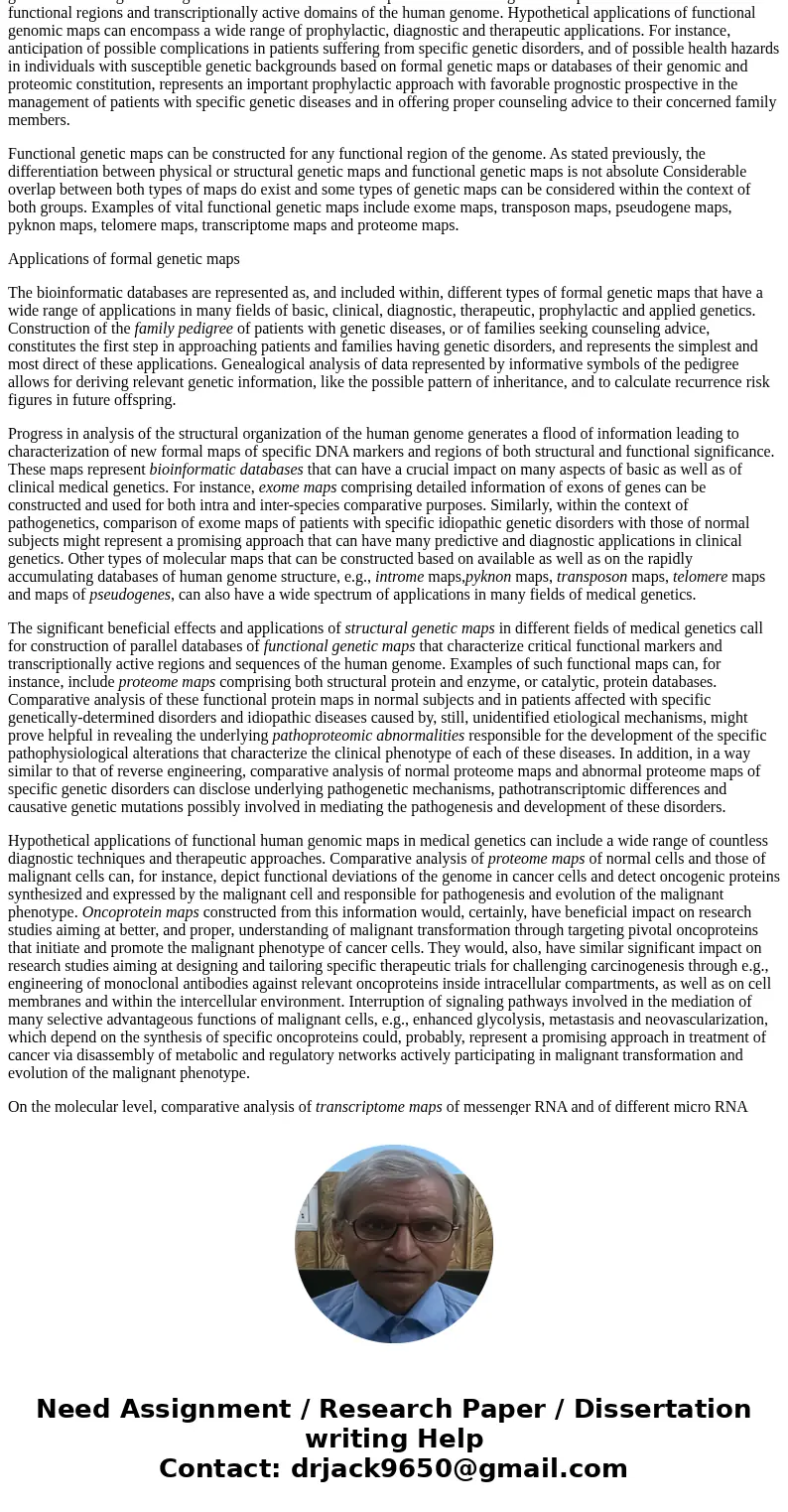
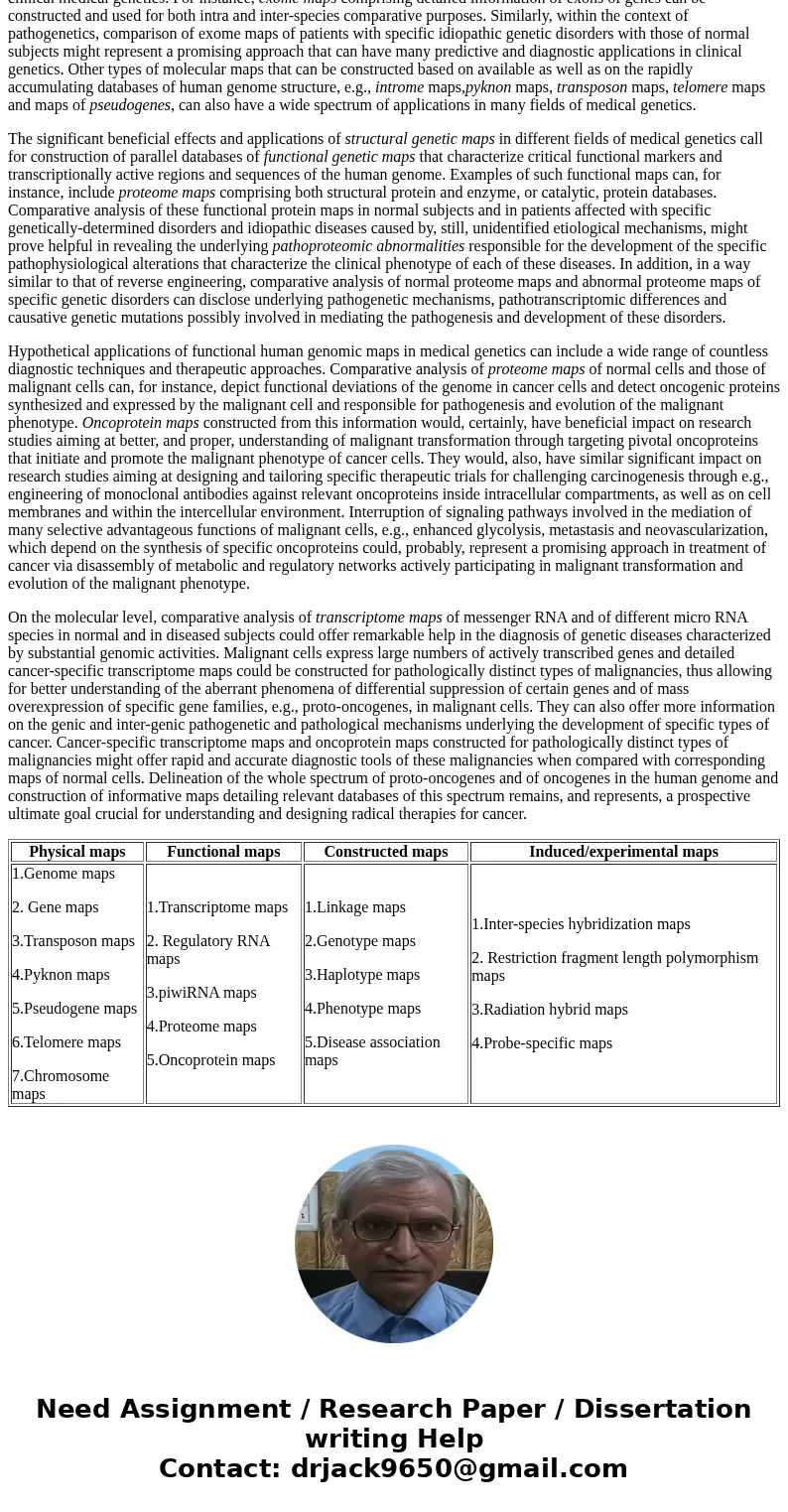
 Homework Sourse
Homework Sourse